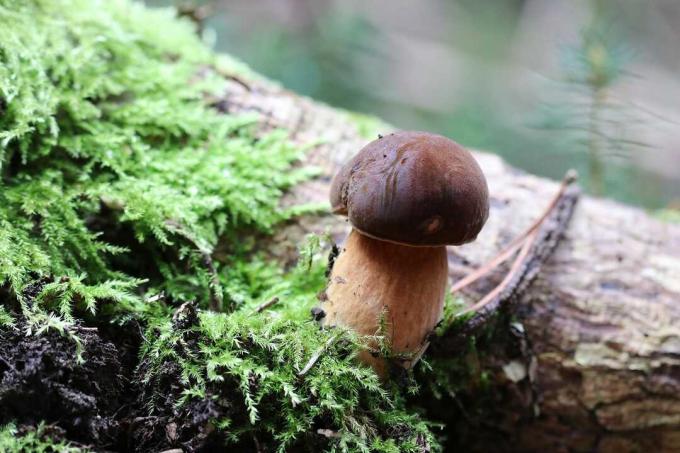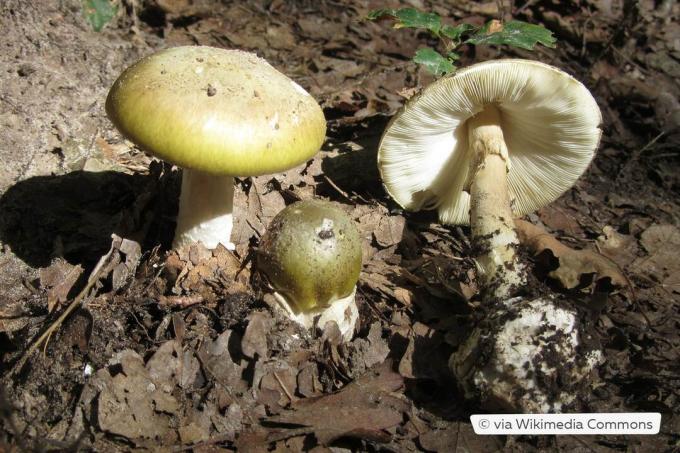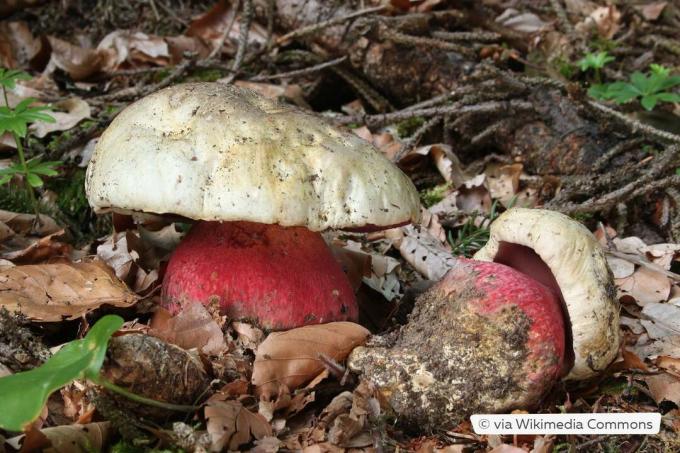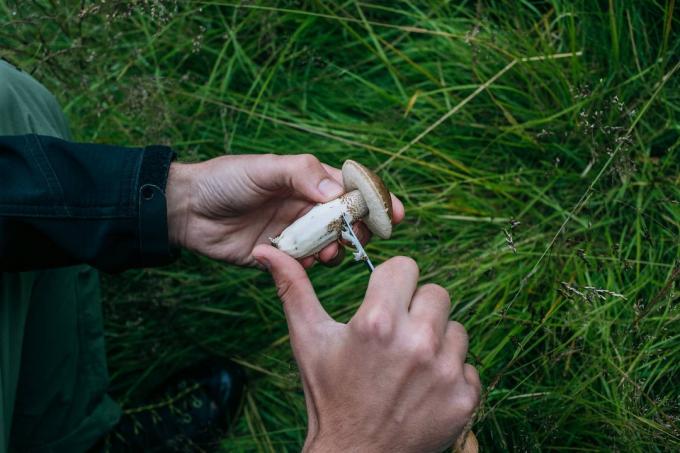
Do you also look forward to the start of the mushroom season in late summer every year? With our tips, collecting mushrooms will be even more fun and the baskets will fill up faster.
To the point
- Mushrooms grow at any time of the year
- Late summer is high season for mushroom pickers
- normal household quantities permitted
- Pick mushrooms carefully
- If you have unknown specimens, consult a mushroom consultant
Table of contents
- Tips for collecting mushrooms for beginners
- Prepare well when collecting mushrooms
- Harvest mushrooms correctly
- Collect mushrooms only for your own needs
- Transport mushrooms carefully
- Recognize mushroom locations
- Take advantage of favorable weather
- Recognize important varieties
- Consider various characteristics
- Double check for young mushrooms
- safety first
- Do not destroy inedible mushrooms
- Observe mushrooms while cleaning and preparing
- Cook mushrooms thoroughly
- React correctly in an emergency
- frequently asked Questions
Tips for collecting mushrooms for beginners
Especially for newcomers to the world of mushrooms, it can quickly become overwhelming to find the right way to get started and the necessary utensils. We have put together important tips for exactly this situation so that you too can take a basket full of mushrooms home with you.

Prepare well when collecting mushrooms
If this is your first time going into the forest to pick mushrooms, it may be wise to get help from someone who has picked mushrooms before. Especially if you don't have a mushroom identification book to hand or feel too unsure, it can be advisable to have support. It is important to think about the route before setting off so that you don't get lost.
Before heading out into the forest, pack everything you need:
- sharp pocket knife
- Basket or air-permeable bag for collecting
- Brush for rough cleaning
- Mushroom identification book
Harvest mushrooms correctly
Harvesting mushrooms also needs to be learned. Once you have identified a mushroom with certainty, you can pick it. Carefully turn the mushrooms out of the ground or cut them just above the ground. In this way, the mycelium in the forest floor is not severely injured and new mushrooms can soon grow back. Avoid arbitrarily cutting off mushrooms just to analyze them better.

After collecting, roughly remove any contamination from the mushroom with a brush and place it in the basket.
Collect mushrooms only for your own needs
Mushrooms spoil quickly. If you want to process them fresh, only collect as much as you can use in the same day. If the harvest turned out to be a little more bountiful, there are some Methods for drying them or even freeze.
Only collecting is permitted for your own needs. That's about one to two kilograms.
Transport mushrooms carefully
You often see mushrooms being transported in plastic bags. This causes the mushrooms to start sweating. Baskets or air-permeable linen bags are better. This means the surface remains pleasantly dry and velvety.
Recognize mushroom locations
Mushrooms grow almost everywhere. Anyone looking for chestnuts and porcini mushrooms will find them in deciduous and mixed forests on mossy areas. Meadow mushrooms can be found in meadows. Honey fungus grows on rotten tree stumps.

So that you don't go home empty-handed, it's best to take a mushroom expert with you. Also, stay away from areas that have just been walked on. Keep an eye out for other mushroom pickers and try taking a different route.
Try to go to the forest as early as possible to avoid disappointment.
Take advantage of favorable weather
When it is warm for a few days in autumn after rainy weather, the mushrooms sprout from the ground. However, if the drought, cold and constant rain persist, the mushroom pickers come away empty-handed.
Recognize important varieties
We recommend always taking a mushroom identification book with you. In the forest, network coverage is often not sufficient to identify mushrooms with a smartphone. Find out beforehand about the edible and poisonous species commonly found in the region.
There are many apps that make identifying mushrooms easy. These are usually very reliable and accurate, and if you have a sufficient internet connection in the forest, they are great to try out. If in doubt, you should still consult the book again or seek advice from experts.
You should leave these poisonous varieties alone
Be careful with mushrooms with white lamellae, bulbous feet and white dots on the cap! Some native mushrooms are poisonous and confusion with non-poisonous mushrooms cannot always be ruled out.
fly agaric

- Cap: red with white dots
- Slats: white
- Stalk: white
Green death cap mushroom

- Cap: green-grey with white dots
- Slats: white
- Stalk: white with a bulbous foot
Panther mushroom

- Cap: light brown with white dots
- Slats: white
- Stalk: white
Satan Mushroom

- Cap: light gray
- Tubes: first yellow, later orange to red, turning bluish when pressure is applied
- Stalk: thick
Even beginners can collect these edible mushrooms
If you have little experience collecting mushrooms, you should Boletus such as chestnuts, porcini mushrooms, birch mushrooms and redcaps. The risk of confusion with inedible or poisonous mushrooms is low here.
Birch mushroom or birch boletus

- Location: near birch trees
- Stalk: light with black scales
- Cap: yellow-brown to grey-brown, greasy in damp weather
- Tubes: White yellow
- Characteristic: white meat turns blue when cooked
- Taste: mild, aromatic
Redcap

- Location: near birch trees
- Stalk: light with black scales
- Cap: brick red
- Tubes: white-yellow, grayish
- Characteristic: White meat turns gray-purple when cut and gray when cooked
- Taste: mild, aromatic
Redcaps are rarely attacked by maggots.
Chestnut boletus

- Location: in coniferous and mixed forests
- Stalk: brownish marbled
- Cap: chestnut brown, velvety, diameter up to 12 centimeters
- Tubes: light yellow, turn blue when pressed
- Characteristic: white meat turns blue when cut
- Taste: mild, aromatic, excellent edible mushroom
mushroom

- Location: in Pine and mixed forests
- Stalk: brownish marbled
- Cap: brown with white edge, leathery
- Tubes: white to light yellow
- Characteristic: white, firm flesh
- Taste: nutty, excellent edible mushroom
Consider various characteristics
To distinguish poisonous from edible mushrooms, it is not enough to check one characteristic. Only the presence of several characteristics can lead to a result.
Double check for young mushrooms
Young mushrooms often do not yet show all the characteristics. Even for experienced mushroom connoisseurs, it is difficult to distinguish poisonous from edible specimens. Leave the small mushrooms standing. This means they can still grow so that another mushroom picker can be happy or a forest animal can find valuable food.
safety first
Leave mushrooms where you cannot definitely rule out toxicity! Maybe another collector finds the mushroom and can safely rule out toxicity and is happy about it.
Do not destroy inedible mushrooms
Mushrooms fulfill important tasks in nature. Also, do not destroy the mushrooms that you do not want to take with you. Even the specimens that are inedible to humans and those eaten by maggots often provide food or habitat for animals and insects.
Observe mushrooms while cleaning and preparing
Many mushrooms change color when they are cut and cleaned. The cut surfaces often turn blue or black. Observe these changes carefully and compare them with the illustrations in the identification book or from the Internet.

Cook mushrooms thoroughly
Many mushrooms, e.g. b. the honey mushroom, are poisonous or inedible raw. It is important to cook them thoroughly and not to taste them during preparation.
It is wrong to think that maggots or snails only attack edible mushrooms. That is no Sign of non-toxicity!
React correctly in an emergency
If you suspect mushroom poisoning, don't hesitate! Every minute counts. Go to the emergency room of the nearest hospital or call an ambulance as quickly as possible. Bring any fungal debris or vomit with you for examination.
These signs indicate mushroom poisoning:
- severe gastrointestinal complaints, which usually occur suddenly
- nausea
- Vomit
- Difficulty breathing
- heart racing
- dizziness
- Circulatory problems
- sudden sweats
The symptoms can occur shortly after consumption, but also after a few hours or days.
frequently asked Questions
In contrast to Italy, where a collecting permit must be obtained, in Germany everyone is allowed to collect mushrooms in normal household quantities. One to two kilograms is considered normal for household use. As with other wild fruits and flowers, the hand bouquet rule applies. It states that anyone who goes out in the forest for the purpose of recreation can take a so-called hand bouquet of flowers, forest fruits or mushrooms with them.
Collecting mushrooms is prohibited in nature reserves, national parks and on private land.
The sale of wild mushrooms is only permitted to persons who have a special permit.
Mushrooms are healthy. They contain few calories and are low in cholesterol. They are rich in vitamins and trace elements. Mushrooms contain valuable proteins and fiber.

